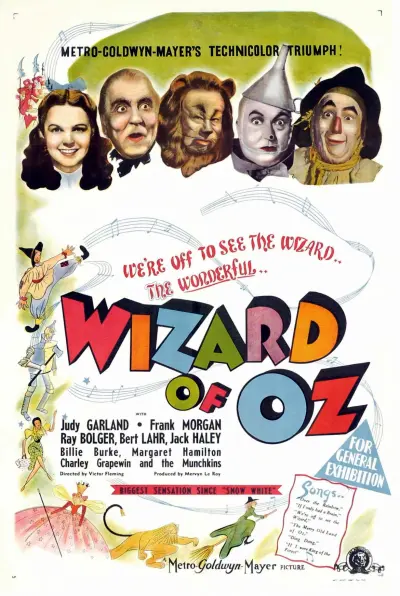
When we pull back the curtain, the timeless tale of 'The Wizard of Oz' reveals a technicolor world of wonder that is still as enchanting today as it was in 1939.
Based on L. Frank Baum's novel, the film follows Dorothy Gale, a Kansas farm girl who is swept away by a twister to the magical Land of Oz. Desperate to return home, she sets off on a journey along the Yellow Brick Road to seek the Wizard, believed to have the power to send her back. Along the way, she befriends a Scarecrow seeking a brain, a Tin Man in search of a heart, and a Cowardly Lion who craves courage—emblematic companions who each reflect parts of Dorothy's own journey.
The heart of the story lies in Dorothy's profound realization that she already possesses the strength and love she seeks in her adventures. Dorothy's famous chant of 'There's no place like home' is not just about the physicality of home, but about recognizing the power within oneself—a central theme woven throughout the narrative.
The colorful companions Dorothy meets mirror her own insecurities and desires. They are on a quest not just for tangible tokens of intellect, love, and bravery, but for self-acceptance and self-realization. The iconic song 'Over the Rainbow' serves as a poignant testament to this yearning for something more—an emblem of dreams and the hope that is essential to the human spirit.
In terms of symbolism, the Emerald City and the Wizard himself represent the illusion of power and the deceptive nature of appearances. When Toto pulls back the curtain, the "Great and Powerful" Wizard is revealed to be nothing more than a man using smoke and mirrors. This moment serves as a sharp critique of ostensible figures of authority, suggesting that authenticity and personal power are much more valuable than any constructed facade. The Wizard's shortcomings and his departure in a balloon signify the end of relying on external salvation, reinforcing the film's message of inner strength and self-reliance.
The thematic exploration in 'The Wizard of Oz' extends beyond the individual level and also comments on the socio-political climate of its time. Some interpretations align the characters and their quests with the political, economic, and social issues of 1930s America. For instance, the Scarecrow could represent the American farmer, the Tin Man as the dehumanized industrial worker, and the Lion as a leader lacking the courage to make bold decisions. Dorothy's silver shoes (changed to ruby slippers for the film's technicolor appeal) have even been thought to symbolize the monetary debate between the gold standard and the use of silver coinage.
But we must not forget the Wicked Witch of the West and the Good Witch Glinda, characters who further deepen the film's exploration of good versus evil. Good and evil are depicted as inherent parts of the world, yet the movie suggests our capacity to choose our own paths. The melting of the Wicked Witch signifies the collapse of malevolence under its own iniquity, and Glinda's revelation to Dorothy that she had the power to return home all along reinforces the message of self-discovery and the triumph of intrinsic goodness.
In the end, 'The Wizard of Oz' is more than just a story of a girl and her dog navigating a dream-like world. It is a narrative rich with meaning, where every character and scenario serves a deeper purpose. The film, with every viewing, invites us into a kaleidoscope of lessons about bravery, intelligence, heart, and the quintessential American value of individualism. Just like Dorothy learns, perhaps the magic we often seek is already within us, and the roads we travel are simply the ways we uncover it.

